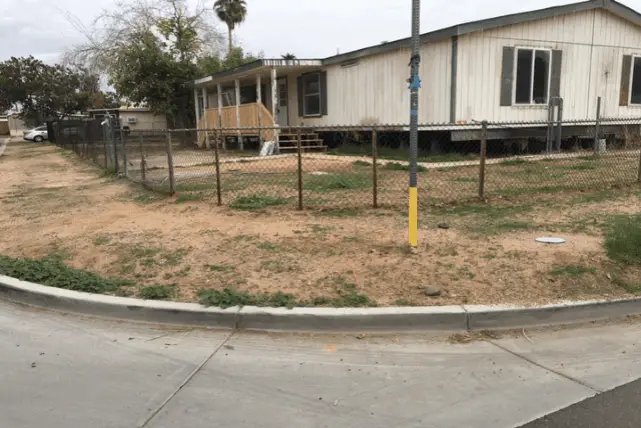Older manufactured homes are far less expensive to buy than a new mobile home, and a fraction of the cost of a site-built home. Whether you plan to live in the home, flip it, or buy it as a rental investment, does it make sense to invest money into an older home?
Table of Contents
The Short Answer
At Mobile Home Friend, our answer to this question is a RESOUNDING “YES! We have done this with homes that were given to us, homes that we paid less than $1,000 for and homes that we’ve paid up to $10,000 for. We’ve yet to lose money on any of them! We will caution that if the home is a pre-HUD (built prior to June 1976) it may not be the wisest choice.
That said, approach remodeling any mobile home with CAUTION! There are lots of things to look out for in making the decision on how much remodeling you should do.
What Are You Looking To Do With The Home?
A HOME TO LIVE IN?
In the Phoenix area metro area where we live, there are many winter visitors that come to our area to enjoy our sunny warm winters. We have lots of parks that cater to the 55+ crowd. Also, many people under that age also find manufactured homes a great way to have a home of their own at a fraction of the cost of a site-built home.
It is quite simple to find a good mobile home in not so perfect condition for well under $10,000.
A HOME TO FLIP OR RENT OUT?
We’ve had great success at finding older homes in parks or on land that are unsalable. In some cases, they’ve even been given to us. We have invested on the low side $10,000 into these homes and on the high side about $30,000. When the homes are finished, we have quickly sold every home we’ve done for a profit.
Don’t Mobile Homes Just Depreciate In Value
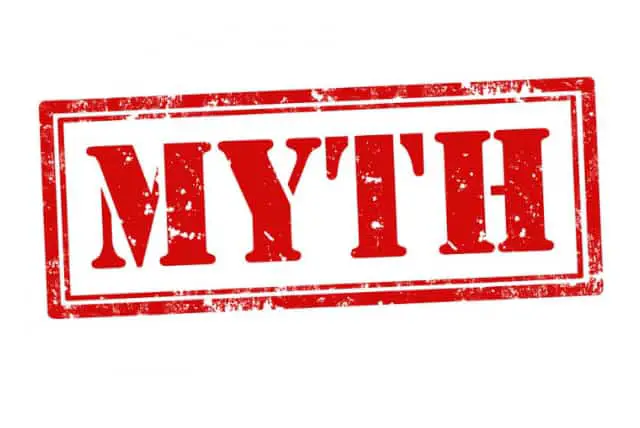
This is a common myth that circulates. But, we’re here to tell you that any structure, apart from the land it sits on will depreciate over time if it is not maintained well. This is true of commercial building, site-built homes and manufactured homes.
Find out more in our post on “Do Mobile Homes Have Good Resale Value?”
What About Comparables?
Just like site built homes, mobile homes must be appraised by a professional in order to qualify for financing. The appraiser is going to search for properties to compare against. The thing about mobile homes, is that it can be difficult to find adequate homes to compare against.
Talk to a Realtor who has plenty of experience with mobile homes. Look at what homes in your market are selling for to determine if what you’re planning on doing to a home is worth it.
Unless you’re going to live in the home, it doesn’t make sense to put more money into a home than you can get back out of it.
Determine Your Budget Before Anything Else!
Maybe you already own the home, and maybe you don’t. Either way, you need to figure out exactly what your budget will be at the outset. This way, you won’t buy the wrong home, and you won’t be left with a halfway finished project. To get the most bang for your buck, knowing what you can spend before hand will save you lots of headache, anxiety and stress during the process.

First determine:
- Is the home going to be in a park?
- Will the home be on its own land?
HOMES IN A PARK
In several cases, we’ve had these given to us by both parks and / or the owners of the home. Other times, we’ve paid $1,000 to about $4,000 for these homes. To most people these homes look like a teardown. They often have water damage, electrical issues, missing HVAC, bad plumbing and NO AESTHETICS!
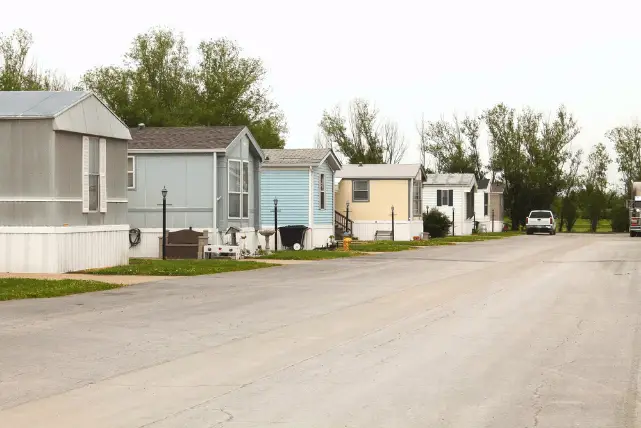
We will attest to you that these can still be good homes. If we’re going to use the homes as a rental, we will invest up to about $7,000 to bring them up to rentable condition. As such, we have less than $10,000 invested and net of the park rent, we clear cashflow of about $350 per month. That is $4,200 cash on cash return for about a $10,000 investment. A whopping 42% annual return.
If you plan on flipping a home in a park, or living in it yourself, you can and should invest quite a bit more money into the home. You may be dealing with the same dump of a home that you are if you plan on making a rental out of it. The difference is that you should be willing to put quite a bit more into it if you expect to sell for a profit or enjoy living in it yourself. We have invested up to $30,000 total in a home in a park and come out with profits at the end.
HOMES ON LAND
In this case, the entry price is going to be much higher. In our area, we are able to find old mobile homes on their own lots for around $30,000 to $40,000. The value in the lot itself is around $35,000.
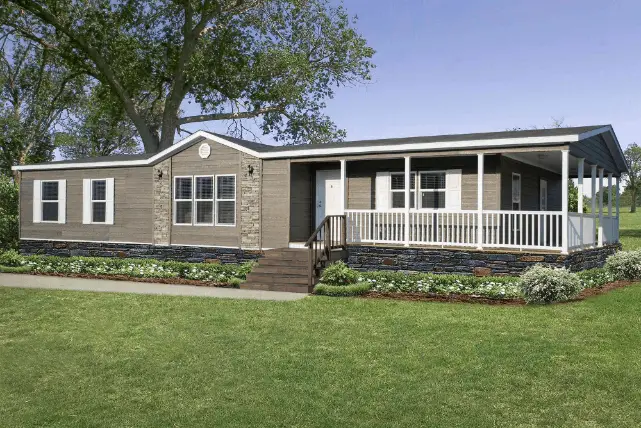
As far as a budget for this type of thing, we have spent a total of about $105,000. We paid $52,000 for the home and land, it had a 1998 2200sf double wide on it. We put $53,000 into the renovation for the home and sold it for $165,000.
Even if we were planning on living in the home, we would have had $60,000 equity in a home that was just like new when it was done. In other cases, we’ve purchased homes on land for about $40,000, put about $25,000 into them and sold them for around $100,000.
Before starting, you should do your research for your area and know the following:
- How much will it cost to find and buy a home you’d have interest in?
- What renovations do you plan on doing?
- How much will each of those renovations cost?
- What will be the value of the home upon completing the renovations?
Some of this information you just tend to learn over time, but in your area, a great way to find out the values of the manufactured homes is to enlist the help of a good realtor. Look online and see how much homes have sold for and what they are listed at.
First Things First (What Needs Repairing)?
If you haven’t already purchased a home and are looking for one to purchase, look for one WITHOUT WATER DAMAGE. Water causes more expensive damage to a mobile home than any other thing. Look for stains on the ceiling, soft spots in the floors. Also push out hard on every exterior wall looking for excessive movement which could be a sign of rot.
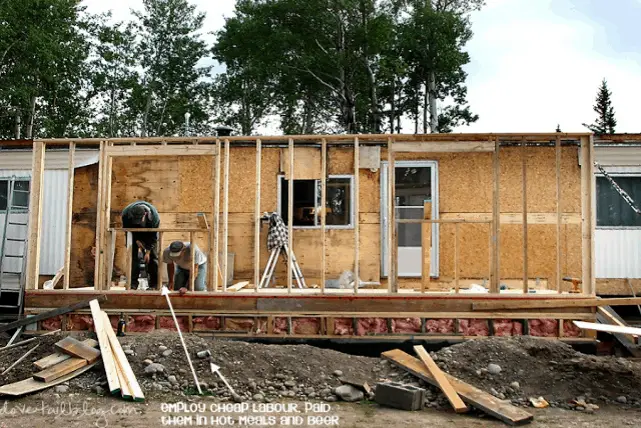
The doors and cabinets should close properly. If they don’t it is the sign that the home has experienced settling and may need some foundation work.
Also, crawl under the home and look at the underbelly. There is a heavy sheet of plastic called “belly wrap” that holds the insulation up in the floor. Often, if animals have been allowed under the home, the belly wrap has been damaged and important floor insulation pulled out or missing.
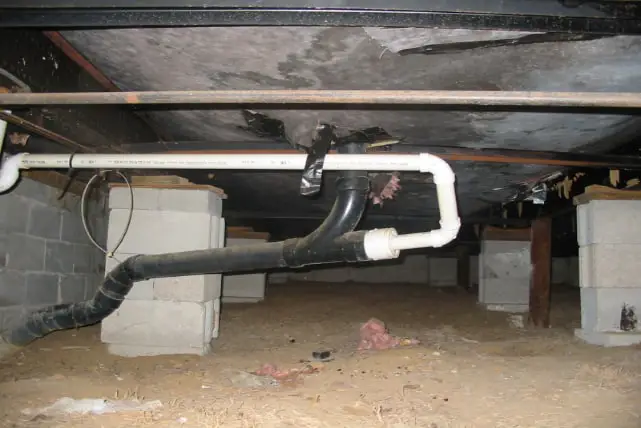
It is always exciting to start adding on the visible cosmetic things that make the home beautiful, such as flooring, cabinets, fixtures and paint. But, if you’re going to end up with the best the home can be and a solid investment, you need to get all of the repairs done first. After all, if you put lipstick on a pig, it will still be a pig.
When dealing remodels of mobile homes we look first at the following 6 areas first:
- Roof
- Walls
- Windows
- Floors
- Wiring
- Plumbing
If the home you have or bought is solid in these five areas, then your remodel will cost you far less than it would otherwise.
For more in depth information, take a look at our blog post “The 12 Most Common Problems With Older Mobile Homes!“
Roof
ASPHALT SHINGLE – Most manufactured homes built in the last 30 years have asphalt shingle roof systems. These shingles will usually last about 20 years before needing replacement. If the shingles are turning black or curling, then it is time for a new roof. If the roof has been allowed to leak for some time, then there may be rotted underpayment that needs replacing before new shingles

The good news is that the roof on most mobile homes is a rectangle. This makes the replacement easier and less costly than many site-built homes of the same size. Materials cost about $650-$2,175 for a single-wide or $1,290-$4,250 for a double-wide, depending on size of unit, thickness or quality of shingle and location. See labor costs below in the Rolled Steel Roofing section.
ROLLED STEEL ROOFING – If you have an older mobile home, especially a single-wide, there is a very good chance that you have one with a rolled steel roof. These look slightly rounded in the pitch. A rolled steel roof is very durable, but has a tendency to leak where the seams run and also along the outside perimeter.

Usually, the roof should be coated with a sealant every few years to keep this from happening. If the roof is in really bad repair, there are typically two ways to handle this:
- Roof Over – This is often a popular method for going over a rolled steel roof. This involves building a frame from 2 x 4s over the top of the home, and installing an asphalt shingle or a metal roof over the framing. Also, added insulation can be added between the new roof top and the old one. A metal roof is a lifetime roof and is the one that we would choose. The materials for a single wide will run about $1,000 to $2,000. For a double wide the materials will usually run from around $1,800 to $3,000.
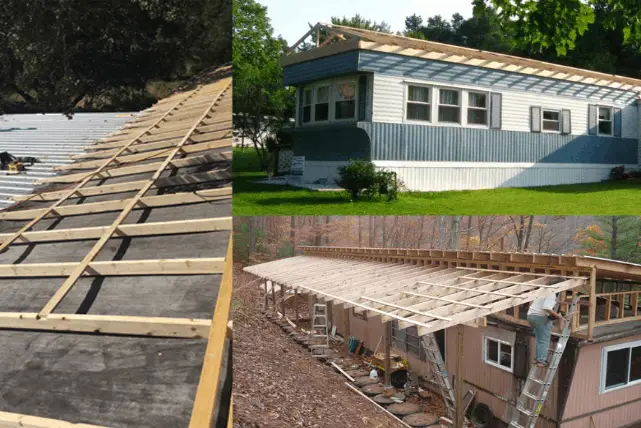
- Rubber Roof – This is becoming more popular in the last number of years. Typical costs: Rubber mobile home roofs are created by stretching a thick blanket-like membrane over an existing roof at a cost of about $1,175-$2,295 in materials for a single-wide and $1,595-$3,610 for a double-wide, depending on size, manufacturer, shipping distance, pitch of roof and number of vents.
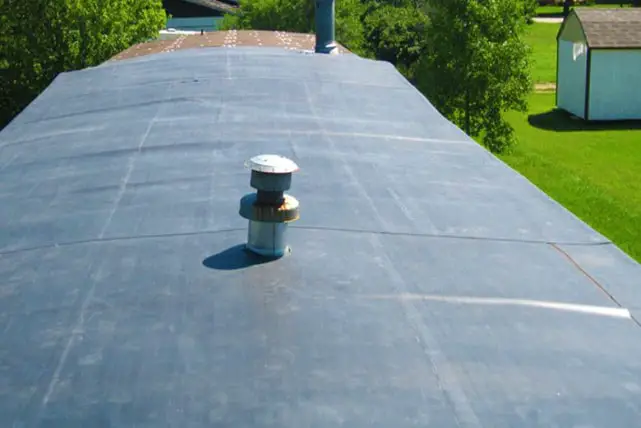
- Labor Cost – Roofing installation costs vary by type of roof. An experienced handyman will be able to install a rubber or metal roof, while a roofing contractor should be consulted for a composition shingle roof where installation prices vary from $675-$2,500 for a single wide to $1,300-$5,000 for a double wide, depending on size of unit, location and shingle quality.
Walls
There is a lot going on here. Exterior walls, interior walls. On the exterior we also have the siding to deal with. On the interior usually drywall or pressed board panels. Let’s dive in for a closer look.
SIDING
- Aluminum – On many older homes, you will find durable aluminum siding that typically lasts a lifetime. It may dent easily though so we often find it in rough condition. For damaged panels you can often find panels at mobile home supply stores that either matches exactly, or is a close match. The panels are fairly inexpensive at around $40 each and can often be installed by a competent handyman.

- Wood – Starting in the 1980s, many manufactured homes were built with plywood or fiber board siding. As long as this type of siding was kept painted and sealed it will last for pretty much ever. But, it is often found rotted because of water damage. Wood siding can be replaced easily and matching, or something really close, is often fairly simple to find. Rarely have we found it necessary to completely replace all of the wood siding. Often around 20%. Replacement costs per panel is often about the same as aluminum.
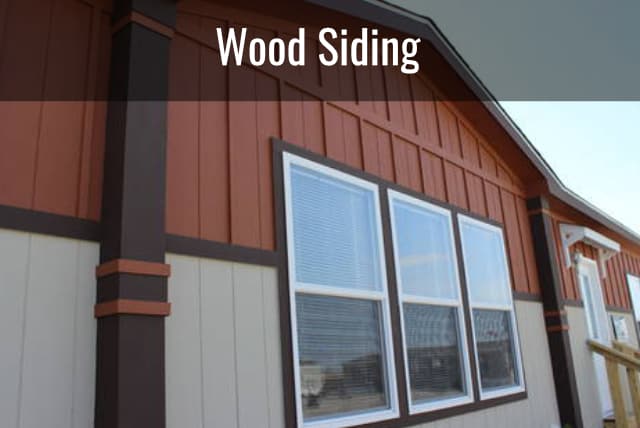
- Cement Fiberboard – This is a newer product for most mobile homes. It is extremely durable and should never need replacing as it does not rot. Also, paint on cement fiber board lasts far longer than paint on wood siding. In Arizona, lots of sun and heat, we see the paint on cement fiberboard lasting over ten years.
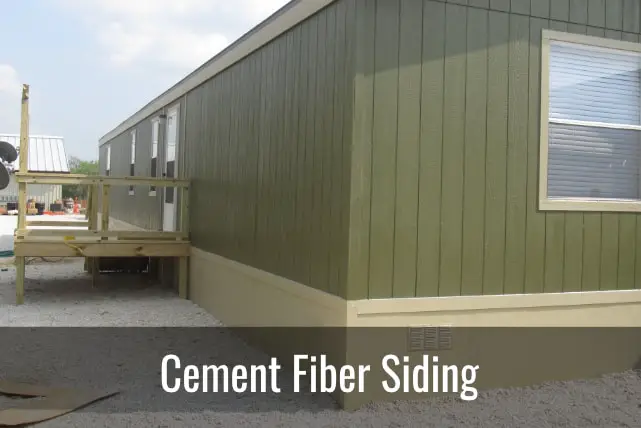
- Vinyl Siding – This is often the most common type of replacement if you’re going to reside the entire home. Vinyl siding is attractive, durable and light weight. However, it isn’t cheap. We have resided a number of homes, typically over very dented up old aluminum siding. The cost to put vinyl siding on a 14 x 70 mobile home would be as follows. Assuming your trailer’s outside walls are 10 feet high, you’ll have 140-square-foot trailer ends and 700-square-foot sides, for a total of 1,680 square feet. The cost to put on new vinyl siding would start just above $3,000 and climb to $12,000 or more. This is why we like to work with panel replacement of the old siding if possible.

INTERIOR WALLS
Waaay back in the day, cheap faux wood paneling was all you found in mobile homes. This lasted up into the early 1980s. About that time 1/4” drywall panels began to be used. Those panels were not taped and textured like they are today. They were often embossed with some type of wallpaper look. Remember wallpaper and the 80s? Ugh!
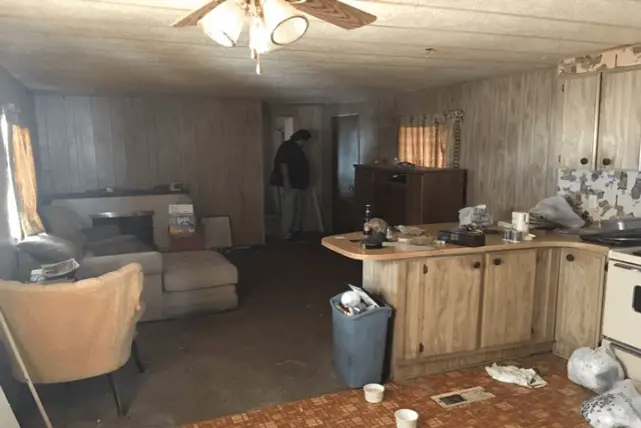
Those old drywall panels usually had molding strips over the seems. There are still a few mobile homes built like that today at the bottom end of the spectrum.
Many newer manufactured homes in the last 20 years have been built with taped and textured drywall just like you’ll find in site-built homes.
One of the great things about mobile homes is that the interior walls are usually non-load bearing partition walls. This means that if you want to blow out a few walls to reconfigure the floor plan, it is easily done.
Painting – In our lower priced mobile home renovations, we have caulked all the seams and painted the old wood paneling. If it is done in light colors, the homes look much bigger and more modern than they did before. In order to get the paint to stick to the older wood paneling, it is necessary to use a primer like Kilz. This is a oil based primer and is quite expensive. In a 14 x 70 mobile home we often have been paying around $1,500 for interior paint because of the expense of the primer. The end result looks great!
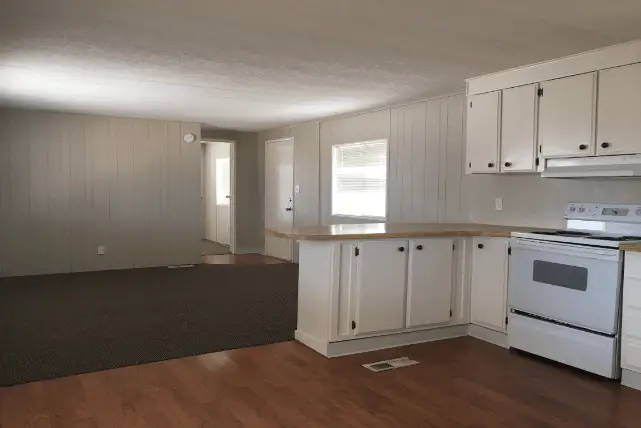
New Drywall – In a number of our higher end flips, we will tape and texture the existing drywall panels it the home has drywall, or actually install all new drywall if it doesn’t. This will run from about $4,000 for a single-wide home to about $6,000 to $8,000 for a double wide. When the home is done, it looks just like a nice site-built home.
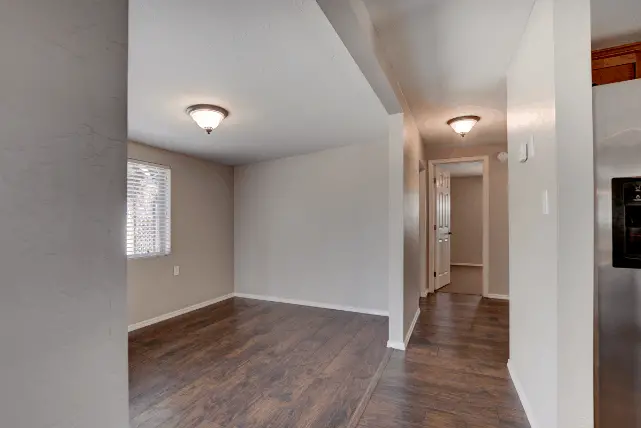
Damage – If you’re staying with the original walls, it is usually pretty simple to find replacement panels for any damage. Often, an older mobile home will have water damage on the outer walls around the windows. Replacing the damaged areas with new panels and then properly painting the entire interior will make the home look solid and inviting.
Windows
Older mobile homes are usually built with the least expensive single pane aluminum framed windows known to man. They are typically nasty, energy inefficient and unsightly. Fortunately, replacing windows in a mobile home is much easier than on a site -built home. Why? Because the windows throughout mobile homes are typically of a standard size used by almost every mobile home manufacturer.
Most mobile home supply houses carry all types of replacement windows:
- Single pane aluminum – just like the cheap ones originally installed
- Double pane aluminum – a good step up in energy efficiency
- Double pane vinyl – next step up for efficiency and appearance
- Double pane vinyl low E – top of the line window
The reason that it is easier and less expensive for a manufactured home is that the labor to remove and replace is far less. The windows in a manufactured home are generally far easier to get to and under less difficult coverings such as stucco, brick veneer or other.
In most of our remodels, we go with a double pane vinyl window. Including the window cost and labor, we typically spend about $200 to $250 per window.
Floors
Very often we find “soft spots” in the flooring systems of mobile homes that we buy. Any floor is only as good as the sub floor underneath it, so repairs should be made prior to putting down the new cosmetic flooring material.
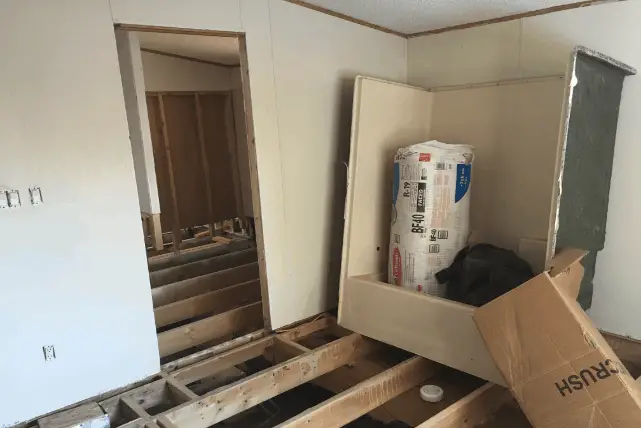
If leaks have occurred in the home over the years, and they probably have, there will be weak spots in the flooring that will need to be repaired. Some of the places to watch for:
- Around toilets
- Next to tubs and showers
- Around sinks
- Around hot water heaters
These are the most common areas to find rot in the subfloors. You should also walk every inch of the floor throughout the home stepping firmly to locate any soft spots. The floor will feel bouncy when you step on one of these weak areas.
Fortunately, mobile home subfloors are quite inexpensive and easy to fix. We once had a 1983 14 x 64 home in a park given to us by the owner. It had roof leaks, holes in the floor, and no HVAC system. This home probably had the worst flooring of any home we’ve taken on. It had rotted subfloors around the tub, toilet, water heater and about 5 holes throughout the home that the owner had been jumping over.
Correcting all of these holes, including labor was around $600.
Check out this post for more detailed information on how to fix the subfloor – “Replacing Mobile Home Floors In 7 Easy Steps”.
Wiring
Go through the home. Check every switch and plug outlet to make sure that they are operating correctly. Also, look at the electrical box inside of the home. Make sure that there have not been any “homemade” additions over the years.
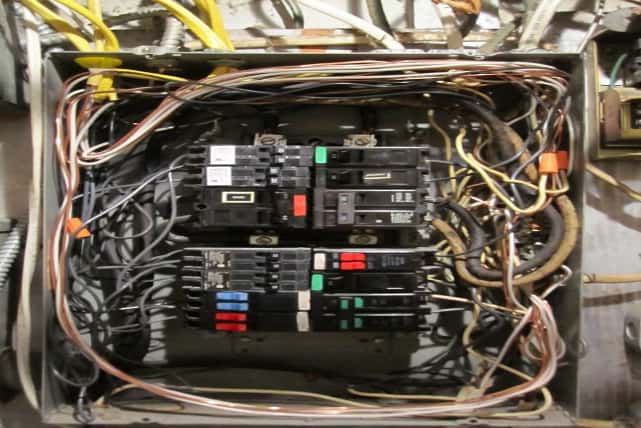
This is an area where we hire an experienced electrician to make any repairs. Fortunately, we have not experienced too many electrical issues and the repairs have almost always been less than $500.
Plumbing
This is an area where we have experienced lots of problems with older homes. From leaks to low water pressure.
Many older homes in the 1980s were built with “polybutylene” pipes that have a tendency to rot from the inside out. These pipes were also used in site-built homes from the same era, and they are known to “burst”.
The great thing about a mobile home is that replacing all of the plumbing in the entire house is a very easy prospect. Because the frame of the home sits up off of the ground, the plumbing is almost always run along the bottom of the home and then goes up through the floor where there is a plumbing fixture. This is true of water supply lines as well as drain lines.

We completely renovated a 1979 14 x 70 recently that was ground set and had terrible pluming pressure. We fixed a leak and once that was done, the new added pressure burst the plumbing in two other locations. Also, in this home we actually moved the location of the kitchen.
We used new “Pex” lines throughout the house. All of the new plumbing was run underneath the home and the entire job was less than $1,000.
Should You Be Gutting The Home To The Studs?
This type of renovation is a huge undertaking and should only be done if you have lots of experience doing so. We’ve seen so many would be remodelers get in over their heads when they tear the home to the studs an removing electrical and plumbing. It is VERY EXPENSIVE to put the home back together and in most cases you will not get your money back out of the home.
If you’re an experienced remodeler with site-built homes, then gutting a mobile home to the studs is not much different. The only way we would do that type of mobile home project is if we were planning on living in the home ourselves.
Gutting a home completely provides you with a clean slate for which you get to make all the choices. But it IS NOT inexpensive to do.
Time To Add Some Value
Mobile homes generally are worth substantially less than site-built homes. This should caution you before taking on really expensive project with the home. Cosmetic changes that are discussed in the following sections are reasonable in cost and make the home attractive and desirable.
Larger projects such as putting on room additions and moving walls usually costs more than the price you will recoup when selling. If you’re planning on selling homes for a profit, it is all about return on investment (ROI).
Now that all of the items that need repairing are done to bring make the structure solid and in good repair, let’s take a look at some of the things that can add more value to the home.
It is a commonly held misconception that mobile homes just depreciate in value and therefore it is not worth remodeling or renovating. This couldn’t be further from the truth. Mobile homes are built to last, and if they are taken care of properly, the structure retains its value and will move up and down in price with the market.
It’s important to understand that our nation is facing a housing shortage. And, as traditional site-built homes prices keep climbing out of reach for many families, manufactured homes increase in demand as well as alternative affordable housing. In our world today, all dwelling units are precious and have demand.
Check out our post “What Is The Life Expectancy Of A Mobile Home?”
Some Of The Top Ways To Add Value
Let’s take a look at some of the best ways that you can add value to the mobile home as a property. Of course, the more you can do yourself with these projects, the less expensive they will be on your budget. The list here will be very similar to that of a site-built home. Making the home a more desirable place to live will increase its value.
We’re in the real estate market in Phoenix. Working with buyers gives me a great idea of what people are willing to pay for. Sometimes, after many years of doing this, I am still surprised at how much some buyers are willing to pay for certain upgrades. Often, it is because they don’t know how to do it themselves, or they don’t want to be troubled with doing it.
Also, it is far easier for them to get the home they want right at the time of purchase rather than having to live through a possibly long period of renovation. Updating the look of the home adds huge value to buyers and to your own pleasure with the home. There are endless ways, styles and budgets that you can choose from. A word of caution that we have learned is to make sure that you DON’T OVER IMPROVE the home for it’s intended purpose.
We see over-improving often in site-built homes and sellers become surprised when they don’t get the money for their homes that they think they should. It is no different for manufactured homes. In fact, because manufactured homes exist in the lower price ranges of residential dwelling, it is even more important to make sure that you don’t over invest in the structure.
I’m going to start this list with the things that cost the least, give the most bang for the buck and then go on from there:
- New plumbing fixtures
- New lighting fixtures
- Door Hardware
- Cabinet Hardware
- Interior Paint
- Exterior Paint
- Skirting
- Flooring
- Countertops
- Cabinets
- New Doors
- Windows
- Awnings
- Shed
- Add On Room
Plumbing Fixtures
Old plumbing fixtures, especially with hard water calcium buildup ages any structure. This is one of the least expensive and easiest ways to update a home and add plenty of value. Modern, clean and stylish faucets and shower heads make a fresh feeling in any home, even if nothing else ever was done.
We always go to one of our favorite box box building supply stores to see what the current trend is, chrome, nickel, burnished bronze, etc. We’re almost always able to find a quality, stylish kitchen faucet for around $120. Individual bathroom vanity sink faucets may run about $60. So, for around $250, the plumbing fixtures can be new and up-to-date.
Lighting Fixtures
Next on our list is to replace all lighting fixtures inside and out. I’m amazed at how many homes I go into that have been “renovated” and they still have the cheap original builder grade light fixtures. Big mistake!
We try to place a ceiling fan in every room. In the kitchen we’ll place a stylish LED fixture that gives plenty of light and a dining room fixture that makes a statement. A new porch light fixture at all exterior locations is a great way to freshen up the outside. Just like pluming fixtures, these come in a variety of great styles. We typically pay about:
- $120 per ceiling fan (Usually about 4 units)
- $100 for kitchen light fixture
- $175 for dining light
- $25 for each outdoor light fixture.
For a typical 3 bedroom manufactured home our budget runs around $800 for the entire house.
Door Hardware
Do you ever walk into a home and immediately notice the chintzy, builder-grade brass door knobs? They are glaringly garish and make any home, site-built or manufactured feel down market and low budget.
Currently, depending on the style you are looking for, chrome, brushed nickel, burnished bronze or black door hardware really update a home. You can buy these in 10-packs to save at the local big box store. As long as you’re buying pack of 10 or more, you should be able to find a great door knob for around $11.
Don’t forget about the hinges. Get hinges to match your door knob. You’ll be able to also find these in packs of 10+ for around $2 each.
HELPFUL HINT FOR INSTALLING HINGES – With your electric drill, put on a screw driver tip. Take off one hinge at a time and then install the new hinge before going to the next hinge. This is an easy DIY project that takes about 15 minutes per door, including changing the door knob.
COST – For a 3 bedroom 2 bath home with about 8 interior door knobs, You might spend around $150 total.
DON’T FORGET THE EXTERIOR DOORS – Door hardware on exterior doors has a tendency to age badly, especially if it is in the sun. These will cost a bit more, but you can likely find a 2-pack that matches the interior knobs for about $45.
Cabinet Hardware
No cabinet hardware is better than “old” cabinet hardware. Dated looking cabinet knobs and drawer pulls certainly make a statement about your kitchen and bathrooms. Great news though, cabinet hardware is inexpensive. Especially if you buy the contractor packs available at your local big box home stores.
If you look around carefully, you’ll be able to find modern, attractive hardware for $1 to $3 per piece. You can typically do the whole house for around $100.
Interior Paint
When renovating a property, paint is one of the most transformative things you can do. Done well, paint will do more to dress up the mobile home over anything else.
But, I’m going to add a word of caution here. Being in the real estate industry, we get to view many, many homes. We often read listing summaries that state that the house has been completely renovated, with new everything. When we get there, what we often find is nothing more than lipstick on a pig. Like we mentioned above, the pig is still a pig.
So how can you make sure that your paint is done right, for a positive lasting impression? One word – PREPARATION!!!
We find that most people just want to go to the store, buy the paint, rollers and brushes and go to work. If only a good paint job were that simple.
Imagine you were planning on painting a car. Let’s say it is an older car with a few dents, many scratches and dings along with some rust. We’ve probably all seen the horrible paint job that some people have done on cars with brushes, ugh, spray cans or discount $300 paint work.
If you want that car to look fantastic, A LOT of prep work needs to be done before the car ever enters the paint booth. For example:
- Body work to remove the dents, scratches and dings
- Removal of body hardware, lights and trim
- Proper sanding and priming
- Careful taping and masking
- Finally, the paint booth
It is absolutely no different with a mobile home, a great look will only be achieve if:
- Repair any drywall or wall panel damage
- Texture in the repaired areas to match the rest of the house (this is an art, and if you are not experienced, hire somebody who is – we always do).
- Carefully caulk all of the home. Where trim and baseboards meet walls, you should make sure that the caulking has sealed any cracks and holes.
- Sand any rough areas, especially damaged wood trim.
- Carefully tape off all hinges and hardware, vents and light fixtures. Removing them is even better.
- Primer should be applied especially if you’re covering over old wood paneling or vinyl coated surfaces.
- Paint– only after all of the above is done properly.
By properly preparing the home for paint, you will end up with a job that you and potential buyers of the home can be proud of. Bad paint adds almost nothing to value, while a great paint job can add $10,000 or more.
Because most older mobile home have tons of trim around and between wall panels, doing the prep work can be extremely cumbersome. Especially when it must be primed with an oil based primer. Even though I consider myself to be a good painter, I always hire the work done. We have developed great relationships with various painters who do great and careful work. We typically pay about $1,500 for painting the interior of a single wide home and about $2,500 for a double wide.
Exterior Paint
Just like interior paint, exterior paint is transformative for the aesthetics of the home. Just like the car analogy that we used previously when discussing the interior painting for a mobile home, the same goes for the exterior. A GOOD PAINT JOB COMPLETELY DEPENDS ON THE EFFORT PUT INTO THE PREPARATION!
The same steps for paint preparation get made on the exterior. Painting the exterior of the home is generally less expensive as it is not only easier to do, but there is less surface to paint. We usually spend about $1,500 for painting the exterior of a manufactured home.
Skirting
Nice skirting certainly adds to the attractiveness of any mobile home, but it also offers many more benefits:
- Adds curb appeal and value to a mobile home.
- Acts as a deterrent for many critters and vermin that may damage air conditioning vents, ducts, wires, and even insulation underneath your property.
- Help keeps snow and water out from under the mobile home.
- Camouflages the foundation.
- Skirting material should allow some air to pass underneath the home to help avoid mold growth.
- Hide cinder blocks, piers, tie-downs, and anything else underneath your property.
- Help insulate the home.
The cost of skirting will certainly vary based on the type you choose. In this case double wide homes are not a lot more than single wides because you are generally only adding about 28 additional linear feet.
For the vinyl type skirting we use, we generally spend about $1,200 for all new skirting.

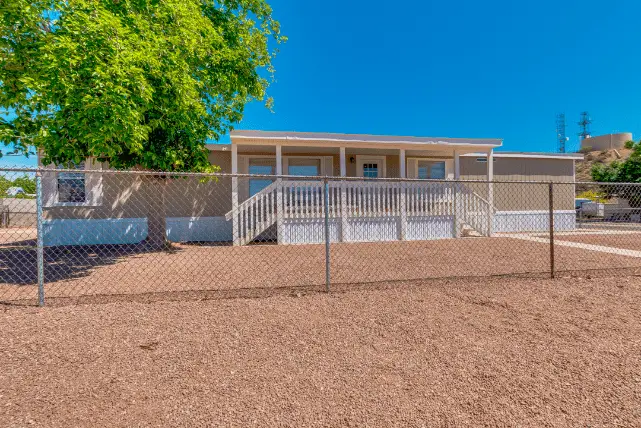
Flooring
Updating the flooring is almost a must and a given. Any floor when new generally looks good, but how well it ages is a different story. Let’s look at the general options that can be used in a mobile home from least expensive to more expensive:
- Carpet
- Vinyl tile (Stick on)
- Laminate
- Ceramic Tile
- Porcelain Tile
- Vinyl Plank
- Wood
When renovating homes, we generally go with carpet in the bedrooms for comfort, noise suppression and cost. We almost always do porcelain tile in the bathrooms for beauty and durability. We could use something less expensive such as vinyl stick on tiles, but they generally look down market.
We usually like to put a single type of flooring throughout the great room, kitchen, dining and halls. Our choice is usually a durable mid-grade laminate.

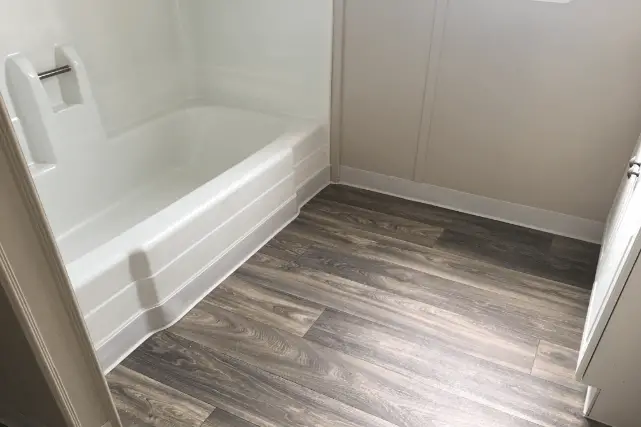
If you’re renovating for your own use, consider the most durable floors, vinyl plank. They look beautiful, mimicking wood almost imperceptibly. Porcelain tile is also a very durable choice, but unless you have extremely solid subfloors, the movement over time will crack the tiles and grout.
For a double wide of around 1,400sf, we typically will spend about $3,000 total on flooring. This is enough to use quality materials for a great value and look.
Countertops
Countertops make an impression. No matter the type you choose, there are attractive finishes available in all types. People usually think of laminate tops as being the least expensive, and most of the times they are; but not always.
It takes a bit of research around your area to determine the type of deal that you can get. Look on Craigslist and Angie’s list for countertop installers able to get your job done. Always ask for references! And, make it a priority to check those references out. We’ve learned the hard way more than once.
Laminate Tops – Your big box home store usually has many selections and sizes of pre-made laminate tops. They are fairly inexpensive to buy; but, if the installation is poor, then the kitchen looks amateurish. What is so hard about the install? Most walls in most homes are not exactly square. Especially if there is a 90 degree L shape that you have to fit the countertops to. A skilled installer will know how to fudge and shim the tops to not only get them level and to match up at the seems, but also to be uniform against the imperfect walls. For a standard mobile home kitchen we will usually spend around $1,000 total for labor and materials.
Granite Tops – In our area, there is a wholesale building supply store where manufacturers bring their goods to be sold on consignment. You can find most everything there, including pre-cut granite tops. These are priced so that they are not much more than laminate. Just like laminate, even more so, the installer you choose will determine how the job comes out. Getting the seems to match and the tops to be level is the top priority. For the same kitchen here, we might spend around $1,400 total. Look around your area, if you’re near a large city, you most likely have something similar. Some granite shops are close to the same price as well, so shop around. You’ll be surprised at the deals you can get.
Quartz – Quarts is a man-made material, not a natural stone. It is very durable, but also tends to be more expensive. In our experience, quartz would run us about $2,000 at the least expensive to do a standard mobile home kitchen.
Cabinets
New cabinets are not always necessary in a good renovation. We often paint the existing cabinets as often as we replace them. A lot of it depends on the kitchen layout and configuration. If we are going to change the configuration, which is easy to do in mobile homes since plumbing and electrical can easily be moved. If we’re going to leave it as is, and the cabinets themselves are in good working order, we will often just paint them.
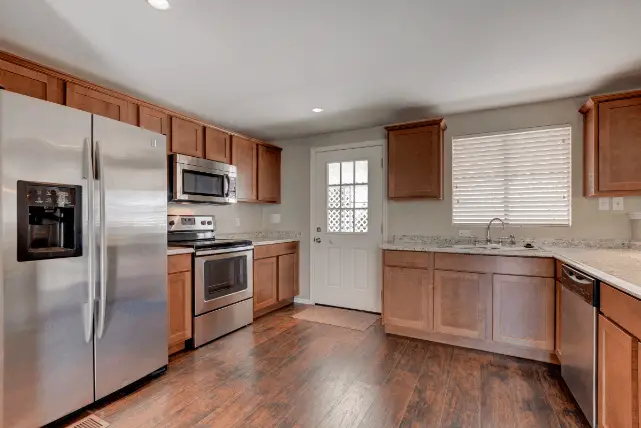
WORD OF CAUTION – When painting cabinets, you don’t just buy some paint and go to work with a brush. Prepping, priming and painting the cabinets is extremely labor intensive if you want a professional and durable job. A special paint is needed as well. When we paint the cabinets in kitchens and bathrooms, we leave it to a professional. The cost of painting is darn close the the cost of replacement as well. We spend around $2,500 for the typical cabinet painting job.
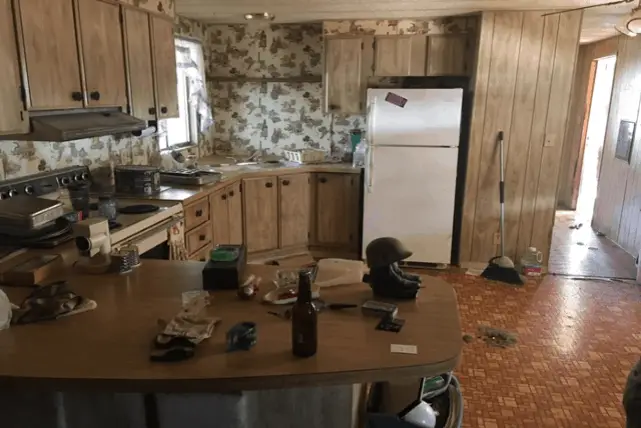
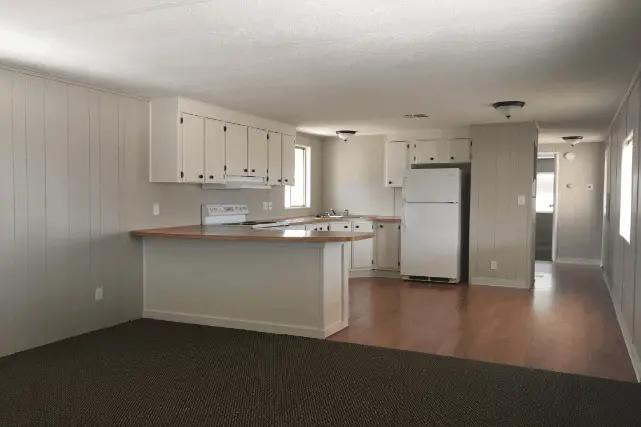
If you’re going to replace your cabinets, you’re often better off not looking at the big box store. They do have some pre-made cabinets in stock that are reasonably price, but often they don’t have all of the sizes needed. If you call around to all the cabinet suppliers in your area, you can usually find better deals.
Here again, the installation job is key. Choose carefully your installer. You can find an experienced good installer for about $35 per box. Installing cabinets is much more than just setting them in place and screwing them to the wall. Remember, floors and walls are rarely square, so the cabinets must be properly shimmed to get them to match up together. CHECK REFERENCES!
New Doors
Often in older homes, the exterior doors are weather beaten and in poor condition. Replacing the exterior doors is almost always a must. You can usually get six panel exterior doors at the big box store for around $120. But, what about the interior doors. In many older homes, the interior doors that were used are of a very low quality and are cut high off the floor. They are also almost always flat panel, hollow core.
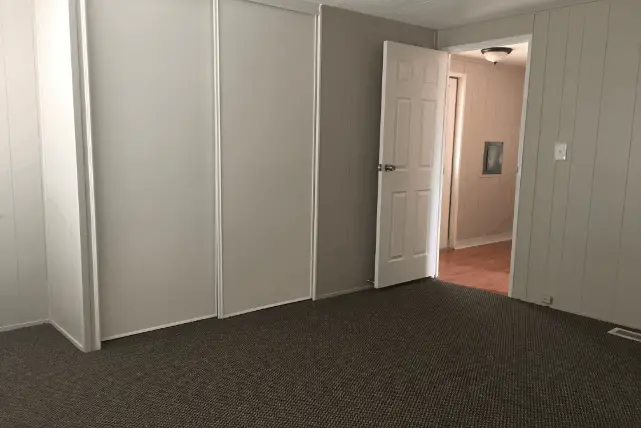
We usually replace interior doors with hollow core, six panel interior doors. These run about $35 at the big box store. An experienced handyman should be able to replace these with little trouble. We generally pay about $30 per door for installation as well. This include any new trim that needs to go around the door.
If you have 2 exterior doors and 8 interior doors, the cost of your doors will run about $520 plus tax. The install cost should run about $300 for a total with tax of about $850. This is a bargain for the added quality appearance that they give the home.
Windows
Most of the older mobile homes that we buy from the 70s through the 90s have single pane aluminum windows in our area. These are very inefficient from an energy standpoint, and usually unsightly as well.
The great thing about mobile home we’ve already covered windows in the section above about making repairs before cosmetic renovations.
Awnings With Carport
In our area of Arizona we get LOTS of sun. If you drive around and look in mobile home parks, or mobile home subdivisions what you find is that most homes have awnings along both sides of the home. On one side, they generally serve as the carport and the other side tends to serve as the covered porch. Most of the time, these awnings extend about 10 feet away from the house.
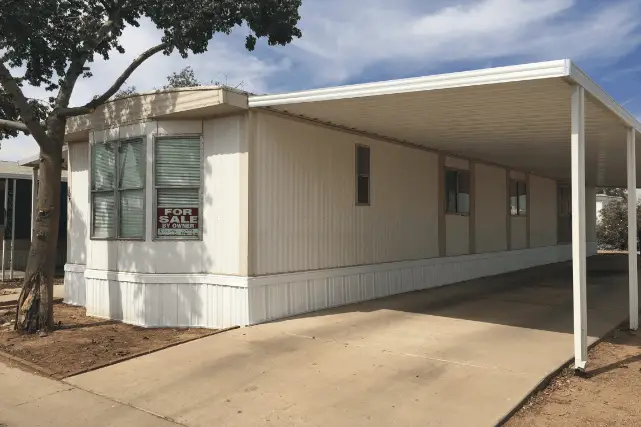
Awnings are quite expensive. They generally cost around $3,500 for a 60 foot length including materials and installation. For both sides this would cost about $7,000. We find that when we buy homes for renovation and resale, we will not recoup the cost of putting on full awnings. Of course, people want them, but they will not usually add enough additional value to the home to cover the cost.
If we buy a home without any awnings, (Rare) then we will put an awning along the porch side of the house extending about 30 feet.
If we were going to live in the home, we would definitely want full awnings on both sides and feel that it is worth the cost. The home not only looks much better, but lives better as well. The awnings keep the sun off the windows, which make home far cooler in the summer. Also, having overhead protection for cars and a nice covered porch to put outdoor furniture.
Shed
Since most mobile homes don’t have a lot of area for storage indoors, and most don’t have garages, a shed is a must for any mobile home. Sheds can cost as little as $700 or as much as $5,000 depending upon what you want. They do add value and make the home much easier to sell.
When flipping a mobile home, if it doesn’t already have a shed, we will usually by a resin shed for around $700. For that price we get a quality shed that is about 8 x 10. If you plan on living in the home yourself, then we would opt for the largest shed that you can fit on your lot. Storage room is a premium feature for any property, site-built home or manufactured. Spending a couple of thousand on a quality shed of around 8 x 12 is money well spent.
Add On Room Additions
Adding on a room makes sense to us only if you plan on living in the home and you want rearrange the floor plan for additional space. You will rarely recoup the cost of adding on a room to a mobile home when you plan to resell the home.
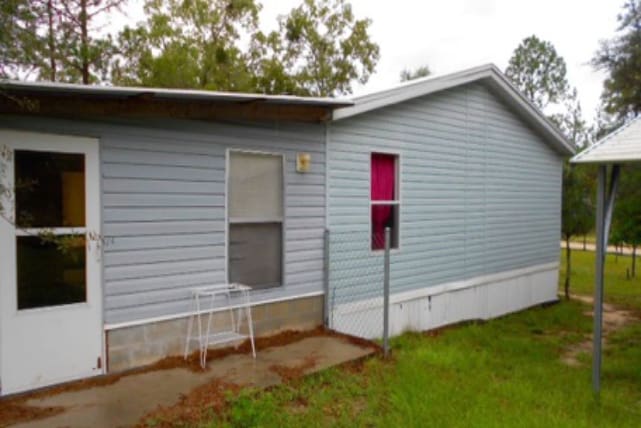
To add on a room properly can easily run about $10,000 and usually will not add anywhere near that much to the value on the market.
Often, we have torn off poorly built additions from mobile homes we have renovated. They often are not professionally built, the sag, squeak, and generally look bad. It is more advantageous to turn the home back into how it was originally built rather than have a wart on the side.
A Word On Making Any Renovation
Be careful before spending lots of money on renovations. Many will give you a return on investment, but others don’t. But, if you are going to make a renovation to the home the QUALITY of that renovation is what makes all the difference on your return.
Let me share a story!
We once bought a double wide home in a park for renovating and flipping. This home was a double-wide, about 1,400sf, 3 beds and 2 baths. It had full awnings on both sides and a nicely done storage room. It was built in the late 1980s, everything was original, and everything was very tired. It was filthy and needed pretty much everything. We paid $4,000 for the house.
At the same time, another house flipper we know bought a double wide home down the street from ours. It was 1,800sf and 4 bedrooms. It was about the same age as ours. This home had been heavily modified inside and the modified floor plan was awful. Our friend spent $8,000 to acquire this home.
We did our normal rehab routine on this home as described in this post. We did not replace the windows, but did pretty much everything else. We spent about $16,000 on the project not including the cost of the home. It took us about 30 days to get it done. Our total investment in the home was $22,000. When we put it on the market, we had a cash buyer within a week and sold the home for $37,000. A profit of $15,000.
We watched closely as our friend worked on the home down the street. He didn’t undo the bad modifications that had been done inside. He spent plenty of money on everything else, though, from new cabinets, flooring, paint and windows. When he finished we walked through the home with him. I tried to be excited for him as he showed the home, but I knew right away that he’d have trouble getting a good price for it. Why?
Everything was dark. Walls, and floor. He tried to cut corners with the labor he employed and the home looked like lipstick on a pig throughout the entire property. The worst thing was not undoing the bad modifications that had been done by a previous owner. He told us he had put over $25,000 into the renovation. So, with his original $8,000 purchase price he had $33,000 invested into the home.
Because the work was substandard, it took him over 3 months to get the property sold for $35,000. Also, he did not get all of his cash back. He got $6,000 down and had to carry a 5 year note on the balance.
This home could have sold for well over $45,000 and gotten a cash offer if the work had of been of a good quality. It often doesn’t pay to cut corners. And, good quality work would not have cost him any more than he already spent.
Related Questions
WHAT IS THE LIFE EXPECTANCY OF A MOBILE HOME?
This is a great question and one that should be considered carefully before making a purchase of a mobile home. What are your plans for the home?
- Will you be living in it full time?
- Will it be a vacation home?
- Will it be an investment property to rent out?
- Are you buying an older home or a newer one?
Carefully consider your answers to these questions in making a decision about what type of mobile home you may want to purchase.
The U.S. Department of Housing and urban Development (HUD) tells us that the manufactured homes built today have a life expectancy of 30 to 55 years; of course depending on how well they are maintained. We feel this is a good estimate for the middle ground. In our experience we have seen some homes even older than 55 years that are in amazing condition. We’ve also seen others that are less than 15 years old that seem ready to be scrapped.
For additional information see our blog post “What Is The Life Expectancy Of A Mobile Home?”
HOW MUCH DOES IT COST TO MOVE A MOBILE HOME?
“Mobile Home”! Just the name alone sounds like you should be able to easily hitch it up and haul it off to a new location. This was easier back in the early days when the homes were much smaller. Today, the process is a massive undertaking and expensive. It is much more involved than it used to be back in the day. So how much does it cost? Let’s take a look…
- Singlewide – $1,000 to $8,000
- Doublewide – $2,000 to $16,000
- Triplewide – $3,000 to $24,000
At first glance you may wonder why there is such a wide variation in pricing. The prices depend largely on how much you do yourself and how much you pay others to have done. The lower end are just the prices for moving the home (maybe up to 60 miles or so). There are far more costs involved, so let’s dive in and take a look at what you can realistically expect to spend if you really want to move a manufactured home.
For additional information see our blog post “How Much Does It Cost To Move A Mobile Home?”

